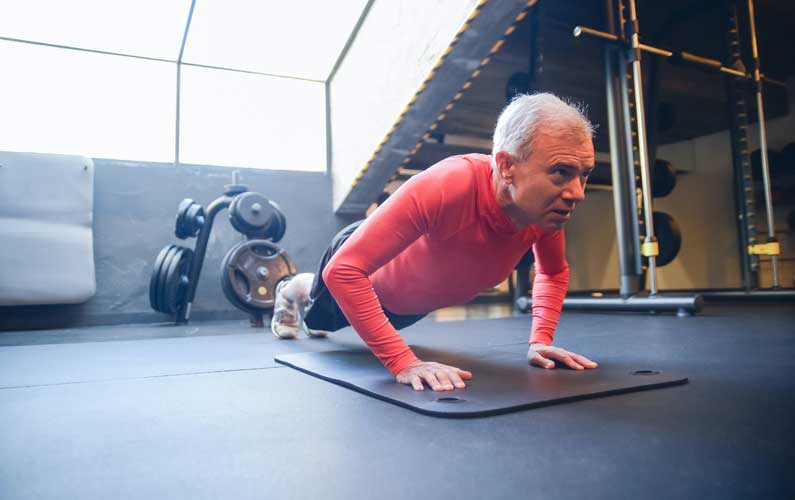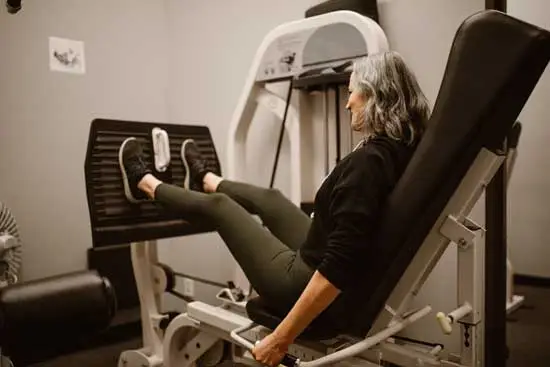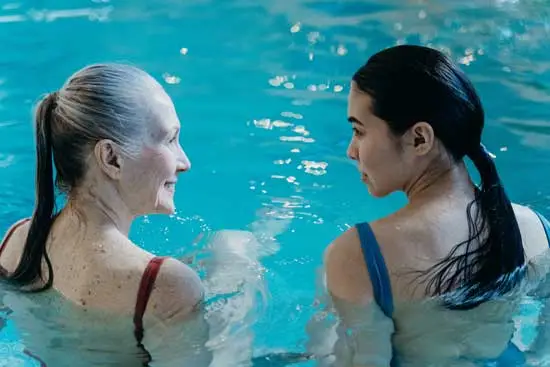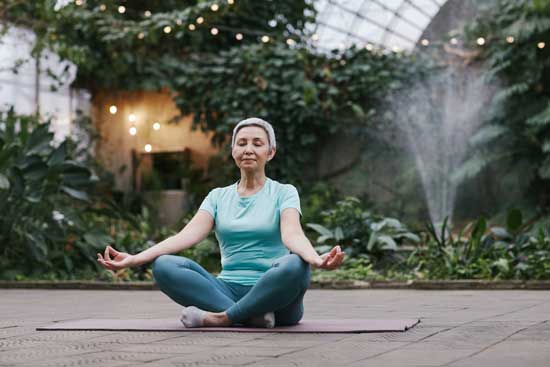
Best Home Gym for Seniors
Regular exercise for seniors isn’t just about avoiding heart attacks or high blood pressure; it’s about boosting your mobility, balance, strength, and the secret sauce to eternal happiness!
Building a home gym tailored to the specific needs of seniors can be a fantastic investment in long-term health and happiness.
In this comprehensive guide, we will explore the best equipment, safety considerations, and exercise routines for seniors looking to create an effective and senior-friendly home gym.
Table of Contents
Safety First
Safety should be your top priority when designing a home gym, especially for seniors.
Here are some essential safety considerations:
- Assess your individual health needs: Before starting any exercise program, consult with your healthcare provider to identify any specific health concerns or limitations. They can provide guidance on the types of exercises that are safe and beneficial for you.
- Consult with a healthcare professional: If you have any chronic medical conditions or mobility issues, consider consulting a physical therapist or a fitness professional experienced in working with seniors. They can create a tailored exercise plan and ensure you’re using equipment correctly.
- Install safety features: Depending on your needs, you may want to install safety features like grab bars, non-slip flooring, and an emergency communication system in your home gym. These additions can provide peace of mind and prevent accidents.
Choosing the Right Space
Before you begin selecting equipment, it’s essential to choose the right space for your home gym. Here are some key considerations:
- Determine the available space in your home: You don’t need a massive area for a home gym. A spare bedroom, basement, garage, or even a corner of your living room can suffice.
- Consider accessibility and ease of movement: Ensure that your chosen space allows for easy access, maneuverability, and safe movement during exercises. Remove clutter and obstacles that could pose tripping hazards.
- Ensure proper lighting and ventilation: Adequate lighting and ventilation are crucial for safety and comfort. Natural light and fresh air can make your workouts more enjoyable.
Essential Equipment for a Senior Home Gym
Now that you’ve addressed safety concerns and selected a suitable space, let’s explore the essential equipment for a senior-friendly home gym:
Cardiovascular equipment
Stationary bike: A low-impact option that’s gentle on the joints and great for cardiovascular health.
Treadmill: If space allows, a treadmill with handrails can provide a stable walking surface for seniors.
Elliptical trainer: This machine offers a full-body workout with minimal impact on the joints.
Rowing machine: A low-impact, full-body workout that helps improve cardiovascular fitness and strength.
Strength training equipment
Resistance bands: Versatile and lightweight, resistance bands provide variable resistance for strength training exercises.
Dumbbells: Opt for adjustable dumbbells to have various weight options without taking up too much space.
Weighted medicine balls: Great for functional strength and balance exercises.
Resistance machines: If space and budget allow, consider machines designed for seniors, such as those targeting leg and upper body strength.
Flexibility and balance tools
Yoga mat: Useful for stretching, yoga, and core exercises.
Balance board: Enhances stability and helps prevent falls by improving balance.
Foam roller: Ideal for self-myofascial release and muscle relaxation.
Stretching bands: Assist with stretching exercises, promoting flexibility.
Low-impact options
Pool or water aerobics equipment: Water-based exercises are gentle on the joints and provide resistance for strength training.
Recumbent exercise bike: A reclined position and back support make this bike easier on the lower back.
Pilates equipment: Pilates can improve core strength and flexibility, and specialized equipment like reformers can be adapted for seniors.
Adaptive equipment for seniors with mobility challenges
Wheelchair-accessible machines: Some manufacturers offer exercise machines designed for use with wheelchairs.
Chair exercise equipment: Modified exercise equipment that can be used while seated, including pedal exercisers and resistance bands.
When selecting equipment, prioritize items that align with your fitness goals, space constraints, and budget. Keep in mind that versatility and ease of use are essential for seniors.
Setting Up Your Senior-Friendly Home Gym
Once you’ve acquired the necessary equipment, it’s essential to set up your home gym for maximum effectiveness and comfort.
Proper storage and organization: Organize your equipment in a way that minimizes clutter and maximizes accessibility. Install shelves, hooks, or storage containers to keep your gym tidy and safe.
Creating an inviting and motivating atmosphere: Decorate your gym with motivational quotes, artwork, or personal touches that inspire you to exercise regularly. Make the space a place you look forward to visiting.
Considerations for flooring and mirrors: Opt for non-slip flooring or rubber mats to enhance safety. Installing mirrors can help you monitor your form and technique during exercises.
Comfortable seating and rest areas: Include a comfortable chair or seating area where you can rest between sets or perform seated exercises. This space can also be useful for post-workout relaxation and stretching.
Exercise Routines for Seniors
Now that your home gym is ready, let’s explore some exercise routines tailored to seniors. These routines encompass cardiovascular exercises, strength training exercises, balance and flexibility exercises, and warm-up and cool-down routines.
Cardiovascular exercises
Walking: A brisk walk around your neighborhood or on a treadmill is an excellent cardiovascular workout for seniors.
Cycling: Stationary biking or outdoor cycling is low-impact and great for cardiovascular health.
Swimming or water aerobics: Water-based exercises are gentle on the joints and provide an effective cardiovascular workout.
Strength training exercises
Dumbbell squats: Hold dumbbells at your sides and perform squats to strengthen your legs and glutes.
Seated leg lifts: Sit in a chair and lift one leg at a time to work on leg strength.
Wall push-ups: Perform push-ups against a wall to strengthen your chest and triceps.
Resistance band rows: Anchor a resistance band to a sturdy object and perform rows to target your back and shoulders.
Balance and flexibility exercises
Single-leg stands: Stand on one leg while holding onto a stable surface for balance improvement.
Tai Chi: This ancient martial art emphasizes balance, flexibility, and coordination.
Yoga: Yoga poses can enhance flexibility and balance while promoting relaxation and mindfulness.
Warm-up and cool-down routines
Warm-up: Start with five to ten minutes of light aerobic activity like walking or marching in place. Follow this with dynamic stretches for the major muscle groups.
Cool-down: After your workout, cool down with static stretches to improve flexibility and prevent muscle soreness.
Sample workout plans
Here are two sample workout plans for seniors. Remember to start slowly and gradually increase the intensity and duration of your workouts:
Workout Plan A (Beginner)
Cardiovascular (10-15 minutes): Brisk walking or stationary cycling.
Strength training (10-15 minutes): Dumbbell squats, wall push-ups, and resistance band rows (2 sets of 10-12 reps each).
Balance and flexibility (10-15 minutes): Single-leg stands and gentle yoga stretches.
Cool-down (5-10 minutes): Static stretches for all major muscle groups.
Workout Plan B (Intermediate)
Cardiovascular (15-20 minutes): Stationary cycling or swimming.
Strength training (15-20 minutes): Dumbbell squats, leg lifts, and resistance band rows (3 sets of 10-12 reps each).
Balance and flexibility (15-20 minutes): Tai Chi and yoga poses.
Cool-down (10-15 minutes): Extended static stretches for all major muscle groups.
Remember to adapt these plans based on your fitness level and individual needs. If you experience pain or discomfort during any exercise, stop immediately and consult your healthcare provider or a fitness professional.
Staying Motivated and Consistent
Maintaining a consistent exercise routine is key to reaping the long-term benefits of a senior-friendly home gym.
Here are some tips to help you stay motivated
Setting realistic goals: Establish achievable fitness goals that are specific, measurable, and time-bound. Celebrate your progress along the way.
Tracking progress: Keep a workout journal to record your exercises, sets, and repetitions. Monitoring your progress can be motivating and help you identify areas for improvement.
Finding social support: Consider exercising with a friend or joining a seniors’ fitness class. Social interaction can make workouts more enjoyable and hold you accountable.
Hiring a personal trainer or coach: If you’re new to exercise or have specific fitness goals, working with a knowledgeable trainer can provide personalized guidance and motivation.
Incorporating variety into your workouts: Keep your workouts interesting by trying new exercises or classes. Variety can prevent boredom and plateaus in your fitness progress.
Nutrition and Hydration
A balanced diet is crucial for supporting your fitness goals and overall health. Here are some nutrition and hydration tips for seniors:
Importance of a balanced diet: Focus on a diet rich in fruits, vegetables, whole grains, lean proteins, and healthy fats. Limit processed foods, sugar, and sodium intake.
Staying hydrated: Dehydration can exacerbate muscle stiffness and joint pain. Aim to drink plenty of water throughout the day.
Supplements for seniors: Consider discussing supplements with your healthcare provider, particularly if you have specific nutrient deficiencies or dietary restrictions. Common supplements for seniors include vitamin D, calcium, and omega-3 fatty acids.
Meal planning tips: Plan balanced meals that provide the necessary nutrients to support your workouts and overall health. Eating a well-balanced meal 1-2 hours before exercise can provide the energy you need.
Recovery and Injury Prevention
Recovery is an integral part of any fitness routine, especially for seniors. Here are some recovery and injury prevention tips:
Importance of rest and recovery: Allow your body time to recover between workouts. Adequate rest is essential for muscle repair and injury prevention.
Recognizing and addressing pain or discomfort: Listen to your body. If you experience persistent pain or discomfort during exercise, consult your healthcare provider or a physical therapist.
Preventing common senior exercise injuries: Focus on proper form and technique to reduce the risk of injuries. Start with lighter weights and gradually increase the resistance.
Incorporating stretching and mobility work: Regular stretching and mobility exercises can improve flexibility, reduce muscle tightness, and enhance overall mobility.
Technology and Home Gym for Seniors
Modern technology can be a valuable tool for seniors looking to enhance their home gym experience.
Fitness apps and wearable devices: Numerous fitness apps and wearable devices are designed to track your workouts, monitor your heart rate, and provide exercise routines tailored to your fitness level.
Virtual fitness classes and online resources: Access online workout classes and tutorials that cater to seniors’ needs, from yoga and Pilates to strength training and cardio workouts.
Smart equipment options: Some home gym equipment now comes with built-in technology that tracks your progress and offers interactive workouts.
Seniors-friendly technology considerations: Choose user-friendly and accessible technology that aligns with your abilities and preferences. Seek assistance from family members or tech-savvy friends if needed.
Conclusion
Creating a senior-friendly home gym is a wonderful investment in your health and well-being.
By choosing the right equipment, prioritizing safety, and following a well-rounded exercise routine, you can enjoy the physical and mental benefits of regular exercise well into your golden years.
Remember that it’s never too late to start or continue your fitness journey.
Consult with healthcare professionals as needed, stay consistent, and celebrate your progress along the way.
Your home gym can be the key to a healthier, more active, and fulfilling life as a senior.






![Treadmills vs Running – 7 Factors to Consider [Infographic]](https://weightathome.net/wp-content/uploads/2018/11/treadmill7-440x264.jpg)
![Andres Raposo’s – 4 Minute Fighter Abs [Review]](https://weightathome.net/wp-content/uploads/2018/04/abs-program-440x264.jpg)
